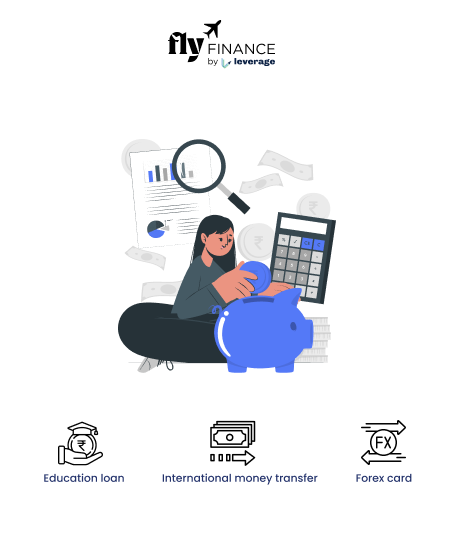Knowing how interest rates are calculated is important if you have taken an education loan from a public, private, or NBFC to finance your study abroad dreams. Different banks offer different interest rates starting from 8% p.a to 25% p.a. Do you know what determines the calculation of interest rates on education loans, why they vary, and how are they calculated?
Factors like loan amount, creditworthiness of the applicant, RLLR, MCLR, collateral security, spread, risk premium etc. contribute to the calculation of education loan interest rates. Let’s check out the details about interest rate calculation on student loans. Know all about the important terms and factors that affect the interest rate calculation.
Table of contents
How do Banks Calculate Student Loan Interest Rates?
Education loan interest rates are either based on RLLR or MCLR. Banks calculate student loan interest rates based on the repo rate set by the RBI and spread (RLLR). The other way to calculate interest rates on education loans is based on the marginal cost of funds and spread (MCLR). It is the rate below which banks cannot charge their borrowers.
Both ways have different approaches to interest rate calculation on student loans. Let’s check out the two major ways of calculating the student loan interest rates-
Also Read: Want an education loan from a government bank? Check out all the information on Union Bank Education Loan through Vidya Lakshmi Portal.
RLLR-based
One of the most used ways to calculate student loan interest rates is by considering the repo rate. It is the rate at which RBI lends money to commercial banks. 6.50% is the current repo rate which was revised in February 2024.
The rate is subject to revision every quarter based on economic conditions like inflation and political stability. Inflation and its effect on education loans is huge as it increases the interest rates.
Lenders also add spread to the repo rate and determine the range of effective ROI on education loans. Spread is the difference between the interest rates at which banks lend money to borrowers and the rate of interest at which they accept money from the RBI. It is decided in consideration of their internal policy and RBI guidelines.
Thus, by adding the repo rate and spread, banks get the calculation on education loan interest rates on education loans. This is known as RLLR-based interest rates. The full form of RLLR is a Repo-linked Loan or Lending Rate.
Student Loan Interest Formula for RLLR= Repo-rate + Spread
Canara Bank education loan interest rates and PNB Education loan interest rates are based on RLLR calculation.
- RLLR-based education loan interest rates are often also referred to as RBLR-based interest rates. The full form is Repo-linked Benchmark Lending Rate. Bank of India education loan interest rates are calculated considering the same.
MCLR-based
Another method to calculate student loan interest rates is the MCLR-based method. MCLR is the Marginal Cost of a funds-based Lending Rate. It is the rate set by the RBI below which banks cannot lend to their customers. It is also a reference rate for the banks. Based on MCLR, they decide the interest rates that can be charged to students on education loans.
Various factors are considered during the calculation of MCLR. These include the marginal cost of funds, operation costs, and tenor premium.
Student Loan Interest Formula for MCLR= Marginal Cost of Funds (Weighted Average Cost of Current and Savings Account Deposits + Borrowings + Term Deposits) + Operation Costs + Tenor Premium
So, the effective interest rates for education loans will be calculated as MCLR + Spread. The spread calculation depends on the borrower’s credit risk and other factors.
- The calculation of student loan interest rates based on MCLR is subject to revision on a monthly or quarterly basis.
- An increase or decrease in MCLR directly impacts the education loan EMI.
Karnataka Bank education loan interest rates and Federal Bank education loan interest rates are two of the major examples of banks that charge student loan interest rates based on MCLR.
EBLR-based
EBLR refers to the External Benchmark Lending Rate. It is a term that refers to the interest rate system where the rates on loans provided by banks are connected to the external benchmark rates. This is a tool that is favoured by banks to enhance transparency and calculate student loan interest rates.
Ultimately, the final set key rate would be a result of adding together the spread rate and EBLR. Banks have the leverage to set the spread over the EBLR. To get the best possible interest rates, it is best to compare the education loan interest rates of different banks and NBFCs to know the profit margin of every bank over the fixed rates of interest.
Union Bank education loan interest rates and Indian Bank education loan interest rates are based on EBLR calculation.
Also Read: We have compiled a list of top private student loans for students going to study abroad. Check our blog to learn the details of different lenders helping to fund study-abroad education.
How Students Can Calculate Student Loan Interest Rates?
Since education loan interest rates are offered on a per per-annum basis, calculating daily and monthly payments of interest rates can help in identifying the amount of principal and interest amount. Students typically use the simple interest rate formula to calculate the student loan interest rate. Check out the different ways to calculate the interest rates on educational loans-
How to Calculate Daily Interest Rates?
If you wish to know the daily interest rate calculation on education loans, you can simply divide the annual interest rate by the number of days in a year.
Student Loan Interest Formula for Daily Interest Rate= Annual interest rate/ number of days (365)
For example- the interest rate on an education loan of INR 30 lakhs availed at 9% p.a will be 0.09/ 365 days = 0.00002465 or 0.0024% approximately.
Factors Affecting Student Loan Interest Rate
Student loan interest rates are calculated based on RLLR, MCLR, and EBLR. However, there are various other factors besides repo rate and marginal cost of funds that affect the student loan interest rates. These are the amount of loan availed, repayment tenure, the creditworthiness of the applicant, and course and university chosen.
CIBIL Score
A credit score of the applicant determines the calculation of effective ROI on an education loan. The higher CIBIL score helps applicants get an education loan at lower interest rates. Thus, always aim to increase CIBIL score for better interest rates on education loans.
Loan Amount and Tenure
The loan amount also determines the education loan interest rate. A higher loan amount with a greater repayment tenure results in higher risk for the lender. Thus, lenders consider the credit risk premium to calculate the student loan interest rates which are higher.
Also Read: Learn all the important details of using SIPs to repay education loans efficiently and plan the repayment of the loan on time.
University and Course Chosen
Certain banks provide interest rate concessions to applicants who secure admission to universities that fall in the top 100 or 200 rankings as per the official websites of QS Rankings and Webometrics. Thus, applying for good universities and courses that generate income-driven employment is ideal to get lower interest rates.
Co-signer
Education loans applied via co-applicants or co-signers help in getting lower interest rates. This is because the co-signer takes full responsibility for the repayment of the education loan. The risk factor for the lender is reduced and thus they calculate student loan interest rates giving concessions.
Collateral
Unsecured education loans often have higher interest rates. Banks do not have any collateral pledged that can be used in case of non-payment of loan by the borrower. Such loans become NPA- non-performing assets leading to losses.
This was all about how to calculate the student loan interest rates. Hope this blog helped in clearing terms like RLLR, MCLR, and EBLR-based education loans. You can calculate the interest rates using the student loan interest formulas and manage your EMI payments wisely.
FAQs
Student loan interest rates are calculated considering the RLLR, MCLR and EBLR. Banks add spread to the same to cover the risk premium.
Education loan interest rates are either based on RLLR or MCLR. Banks calculate student loan interest rates based on the repo rate set by the RBI and spread (RLLR). The other way to calculate interest rates on education loans is based on the marginal cost of funds and spread (MCLR).
RLLR-based student loan interest rates are the interest rate which is calculated considering the repo-rate set by the RBI. Spread is added to give the final and effective interest rates applicable while lending the education loans.
To calculate the daily interest rate, the student loan interest formula is the annual interest rate/ number of days in a year. For example- the interest rate on an education loan of INR 30 lakhs availed at 9% p.a will be 0.09/ 365 days = 0.00002465 or 0.0024% approximately.
There are various other factors besides repo-rate and marginal cost of funds that affect the student loan interest rates. These are the amount of loan availed, repayment tenure, the creditworthiness of the applicant, and course and university chosen.
To know more about education loans, the best bank accounts for students, forex and banking experience for global students or international money transfers, reach out to our experts at 1800572126 to help ease your study abroad experience.




























